Comments / Questions (204)
![]() Sheila Dempsey wrote:
Sheila Dempsey wrote:
So I’m only adding 2 stitches in the entire round? Or 2 in each of the 42 sections so a total of 84 increases?
06.02.2020 - 02:44DROPS Design answered:
Dear Mrs Dempsey, you increase only 2 stitches in the round, you are repeating 42 times A.6 (= 9 sts on last round) = 378 sts + 2 sts increased = 380 sts. Happy crocheting!
06.02.2020 - 10:39
![]() Sheila Dempsey wrote:
Sheila Dempsey wrote:
I am about to start A-6. The otter. Says to work A-6 42 times and AT THE SAME TIME of last round increase 2dc evenly by working 2dc in same dc. Does this mean to do a dc in EVERY dc in the round? I don’t understand when to do the inc.
05.02.2020 - 03:29DROPS Design answered:
Dear Mrs Dempsey, you will find how to increase evenly here - simply crochet 1 more stitch than shown in diagram on 2 different places (there is no double crochet on previous round). Happy crocheting!
05.02.2020 - 08:29
![]() Alice wrote:
Alice wrote:
I made this sweater a few years ago, and this was my first time wearing it. Also my first time seeing the written pattern. I am trying to make it again, but for my 15 month old granddaughter. I Love this pattern!
10.12.2019 - 05:08
![]() Donni Alvarenga wrote:
Donni Alvarenga wrote:
I am not understanding how the sleeve is done. Once I fasten off A7, I'm not sure where the 18 chain goes? Nor how we get to over 50 double crochet. I am missing something. Do you have an photos of how the sleeves look as you work them?
31.10.2019 - 02:49DROPS Design answered:
Dear Mrs Alvarenga, after you cut the yarn after A.7, start the next row crocheting 18 chains, then work 1 double crochet over the 25 stitches of last row in A.7 and crochet 21 chains, turn, and crochet next row with 1 dc in 4th ch from hook, 1 dc in each of the next 17 chains (= 18 dc before the 25 sts), 1 dc in each of the next 25, 1 dc in each of the 18 ch = 18+25+18= 61 double crochets. Happy crocheting!
04.11.2019 - 13:57
![]() Cindy wrote:
Cindy wrote:
I fell in love with this pattern. However, I don't know how to get from A2 sec 1 of 6 to sec 2 and so on? Thank you fir this beautiful pattern.
30.10.2019 - 21:11DROPS Design answered:
Dear Cindy, this should help you to figure out how to read crochet diagrams. Happy crocheting!
04.11.2019 - 13:52
![]() Sandra wrote:
Sandra wrote:
I read what you said about the sleeve but im still confused. where do you start doing the double stitches for the sleeve, is it on the chain you make , or do i chain from a7, or what ? help pleaseeeeee.
05.09.2019 - 23:47DROPS Design answered:
Dear Sandra, sleeves are worked separately from body; you first crochet A.7 = 3 chains, 1 sl st in 1st ch then work back and forth following diagram: on 1st row you work 7 dc in the chain-ring, then on 2nd row you work (2 dc in 1st dc, 1 dc in next dc) x 3 and finish with 2 dc in last dc, continue like this working A.7 back and forth. Happy crocheting!
06.09.2019 - 08:24
![]() Sandra wrote:
Sandra wrote:
When do you start working under the sleeve whole section
01.09.2019 - 21:46DROPS Design answered:
Dear Sandra, I'm afraid I don't get your question here. Sleeves are worked separately from body (circle) back and forth with a seam. For the section after armhole (chains) have been worked, see previous answers. Happy crocheting!
02.09.2019 - 11:02
![]() Sandra wrote:
Sandra wrote:
Does a4 go under arm hole or over?
31.08.2019 - 21:04DROPS Design answered:
Dear Sandra, you will work A.4 over the last row in A.3 = in the stitches from A.3 + in the chain-spaces for amrholes (so that there are 2 holes for each sleeve). Happy crocheting!
02.09.2019 - 10:16
![]() Sandra wrote:
Sandra wrote:
Ok I am having issues with the last part of the xxl size chart. It says to work a4 24 times but the arm holes are on that row. So what do I do?
30.08.2019 - 18:00DROPS Design answered:
Dear Sandra, you work the 5th row in A.3 shaping the armholes at the same time, then on next round, work A.4, ie repeat diagram a total of 24 times in width in the round , ie in the stitches from 5th row on A.3 as well as over the ch-spaces for the armholes = there are 48 ch-spaces in total at the end of 1st row in A.4. Work A.4 1 time in height. Happy crocheting!
02.09.2019 - 08:29
![]() Sandra wrote:
Sandra wrote:
But there are no spaces in the last row of a3 ?
30.08.2019 - 16:47Sandra answered:
Never mind i figured out
30.08.2019 - 17:54
Sea Glass#seaglassjacket |
||||||||||||||||||||||||||||||||||||||||||||||||||||||||||
 |
 |
|||||||||||||||||||||||||||||||||||||||||||||||||||||||||
Crochet DROPS jacket worked in a circle with lace pattern in ”Merino Extra Fine”. Size: S - XXXL.
DROPS 164-16 |
||||||||||||||||||||||||||||||||||||||||||||||||||||||||||
|
CROCHET INFO: Beg every round with dc with 3 ch and finish with 1 sl st in 3rd ch at beg of round, ch does not replace first dc. Beg every dc row with 3 ch. DECREASE TIP: Dec 1 dc by working the next 2 dc tog as follows: Work 1 dc but wait with last pull through (= 2 sts on hook), then work next dc but on last pull through, pull yarn through all 3 sts on hook. PATTERN: See diagrams A.1-A.10. Diagram A.8 shows how round beg and ends. NOTE: In diagram A.2-A.4, A.6 and A.10 first round in diagram is last round on previous diagram, it is not worked but shows how to continue. ---------------------------------------------------------- CIRCLE: Work 5 ch on hook size 5 mm / H/8 with Merino Extra Fine and form 1 ring with 1 sl st in first ch. Then work A.1 as follows: ROUND 1: Work 3 ch - READ CROCHET INFO, 12 dc in ch-ring, finish with 1 sl st in 3rd ch. ROUND 2: Work 2 dc in back loop of every dc = 24 dc. ROUND 3: Work * 2 dc in back loop of first/next dc, 1 dc in back loop of next dc *, repeat from *-* the entire round = 36 dc. REMEMBER THE CROCHET GAUGE! Then work A.2 6 times in total on round. NOTE: A.8 in same diagram shows how every round beg and ends. Note if dc is worked in back loop, in or around st (applies for all diagrams). When A.2 has been worked 1 time vertically, there are 96 dc and 24 ch on round (= 120 sts in total). Piece measures approx. 28 cm / 11" in diameter. Then work A.3 12 times in total on round. When 2-3-4 rounds of A.3 have been worked (circle measures approx. 36-38-40 cm / 14 ¼"-15"-15 ¾" in diameter), there are 156-168-192 sts on round (= 156-168-96 dc and 0-0-96 ch). Now work armholes in the different sizes: SIZE S/M: Round now deviates from diagram because of armhole. Work as follows: Work 3rd round in A.3 as follows (all dc on this round are worked in back loop of dc): Work ch 3, * 2 dc in first dc, 1 dc in each of the next 8 dc *, repeat from *-* 4 more times, 26 ch, skip 26 dc (= armhole), repeat from *-* 6 times in total, 1 dc in each of the next 5 dc AT THE SAME TIME inc 1 dc, 26 ch, skip 26 dc (= armhole), finish with 1 sl st in 3rd ch at beg of round = 116 dc (= 26 ch for each sleeve, 168 sts in total). Work 4th round in A.3 as follows (all dc worked in dc, are worked in back loop on this round): Work ch 3, ** 1 dc in first/next dc/ch, ch 1, * 1 dc in next dc/ch, ch 1, skip 1 dc/ch *, repeat from *-* 4 more times, 1 dc in next dc/ch, ch 1, 1 dc in next dc/ch, ch 1, skip 1 dc/ch **, repeat from **-** 11 more times, work like this over ch-spaces (= sleeve) too, finish with 1 sl st in 3rd ch at beg of round = 96 dc and 96 ch (= 192 sts in total). Then work A.3 as before. When A.3 has been worked 1 time vertically, there are 192 dc on round. Then work A.4 24 times in total on round. SIZE L/XL: Round now deviates from diagram because of armhole. Work as follows: Work 4th round in A.3 as follows (all dc worked in dc, are worked in back loop on this round): Work ch 3, ** 1 dc in first/next dc, ch 1, * 1 dc in next dc, ch 1, skip 1 dc *, repeat from *-* 4 more times, 1 dc in next dc, ch 1, 1 dc in next dc, ch 1, skip 1 dc **, repeat from **-** 2 more times, work 1 dc in next dc, ch 1, 1 dc in next dc, ch 1, skip 1 dc, 1 dc in next dc, ch 1, skip 1 dc, 1 dc in next dc, work 28 ch, skip 28 dc (= armhole), repeat from **-** 4 times in total, work 1 dc in next dc, ch 1, 1 dc in next dc, ch 1, skip 1 dc, 1 dc in next dc, * ch 1, skip 1 dc, 1 dc in next dc *, repeat from *-* 1 more time, work 28 ch, skip 28 dc (= armhole), finish with 1 sl st in 3rd ch at beg of round = 65 dc and 119 ch (= 28 ch for each sleeve, 184 sts in total). Work 5th round in A.3 as follows (all dc worked in dc, are worked in back loop on this round): Work 1 dc in every dc and 1 dc in every ch. Over ch-space for each sleeve work as follows: Work * 1 dc in each of the first ch 6, 2 dc in next ch *, repeat from *-* 3 more times, finish with 1 sl st in 3rd ch at beg of round = 192 dc. Continue working diagram A.3. When A.3 has been worked 1 time vertically, there are 192 dc on round. Then work A.4 24 times in total on round. SIZE XXL/XXXL: Round now deviates from diagram because of armhole. Work as follows: Work 5th round in A.3 as follows (all dc worked in dc, are worked in back loop on this round): Work ch 3, * 1 dc in first/next dc, 1 dc around next ch *, repeat from *-* 24 more times, 1 dc in next dc, 30 ch, skip 15 dc and 15 ch (= 30 sts in total) for armhole, * work 1 dc around next ch, 1 dc in next dc *, repeat from *-* 39 more times, 1 dc around next ch, 30 ch, skip the last 15 dc and 15 ch (= armhole), finish with 1 sl st in 3rd ch at beg of round = 132 dc and 30 ch for each sleeve (= 192 sts in total). Then work A.4 24 times in total on round. Work first round as follows: Work ch 3, * ch 3, skip 3 dc/ch, 1 dc in next dc/ch, ch 3, skip 3 dc/ch, 1 dc in next dc/ch *, repeat from *-* 23 more times, work like this over ch-spaces (= sleeves) too, finish with 1 sl st in 3rd ch at beg of round = 48 ch-spaces. ALL SIZES: When A.4 has been worked 1 time vertically, there are 240 dc on round. Piece measures approx. 54 cm / 21 ¼" in diameter. Then work A.5 24 times in total on round. When A.5 has been worked 1 time vertically, there are 336 dc on round. Piece measures approx. 76 cm / 30" in diameter. Then work A.6 42 times in total on round AT THE SAME TIME on last round of A.6 inc 2 dc evenly by working 2 dc in same dc or work an extra dr around a chain space. When A.6 has been worked 1 time vertically, there are 380 dc on round. Then work A.5 38 times in total on round as follows in the different sizes: SIZE S/M: Work 5 rounds of A.5 = 494 dc. Then work 1 dc in back loop of every dc AT THE SAME TIME inc 42 dc evenly (inc approx. 1 dc in every 12th dc) = 536 dc on round. Piece now measures approx. 110 cm / 43½" in diameter. Then work A.6 67 times in total on round. Fasten off when the first 2 rounds of A.6 have been worked. Piece measures approx. 114 cm / 45" in diameter. SIZE L/XL: Work A.5. When A.5 has been worked 1 time vertically, there are 532 dc on round. Then work 1 dc in back loop of every dc AT THE SAME TIME inc 36 dc evenly (inc approx. 1 dc in every 15th dc) = 568 dc. Piece measures approx. 118 cm / 46½" in diameter. Then work A.6 71 times in total on round. Fasten off when the first 2 rounds of A.6 have been worked. Piece measures approx. 122 cm / 48" in diameter. SIZE XXL/XXXL: Work A.5. When A.5 has been worked 1 time vertically, there are 532 dc on round. Then work 1 dc in back loop of every dc AT THE SAME TIME inc 36 dc evenly (inc approx. 1 dc in every 15th dc) = 568 dc. Piece measures approx. 118 cm / 46½" in diameter. Then work A.6 71 times in total on round. When A.6 has been worked 1 time vertically, there are 639 dc on round. Piece measures approx. 125 cm / 49" in diameter. Work 1 round with 1 dc in back loop of every dc AT THE SAME TIME inc 9 dc evenly = 648 dc. Work A.6 81 times in total on round. Fasten off when the first 2 rounds of A.6 have been worked. Piece measures approx. 130 cm / 51½" in diameter. SLEEVE: Worked back and forth, top down. First work a sleeve cap. Work A.7 - remember CROCHET INFO. When A.7 has been worked 1 time, there are 25 dc on round. Fasten off. Work 14-16-18 loose ch, then work 1 dc in every dc from A.7, finish with 17-19-21 ch (includes 3 ch to turn with). Insert 1 marker in piece, NOW MEASURE PIECE FROM HERE. Work 1 dc in 4th ch from hook, 1 dc in each of the next 13-15-17 ch, 1 dc in every dc, 1 dc in every ch = 53-57-61 dc. Then work 1 dc in every dc. When piece measures 4 cm / 1½", dec 1 dc in each side of piece by working the first 2 dc tog and the last 2 dc tog (= 2 dc dec) – SEE DECREASE TIP! Repeat dec every 3-3-3½ cm / 1"-1"-1 ¼" 10-10-9 more times = 31-35-41 dc. When piece measures 38-39-40 cm / 15"-15¼"-15¾", work piece in the round as follows: Work A.9 6-7-8 times in total on round AT THE SAME TIME on first round dec 1-0-1 dc = 30-35-40 dc. On last round in A.9 dec 2-3-4 dc evenly = 28-32-36 dc. Then work A.10 7-8-9 times in total on round. Fasten off when A.10 has been worked 1 time vertically. Piece measures approx. 63-64-65 cm / 24¾"-25¼"-25½" in total. Work another sleeve the same way. ASSEMBLY: Sew sleeves into circle in outer loop of edge sts. Sew underarm seam. |
||||||||||||||||||||||||||||||||||||||||||||||||||||||||||
Diagram explanations |
||||||||||||||||||||||||||||||||||||||||||||||||||||||||||
|
||||||||||||||||||||||||||||||||||||||||||||||||||||||||||
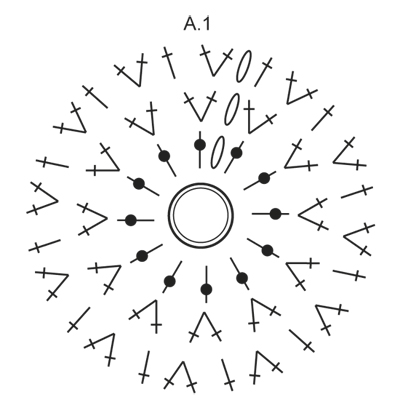
|
||||||||||||||||||||||||||||||||||||||||||||||||||||||||||
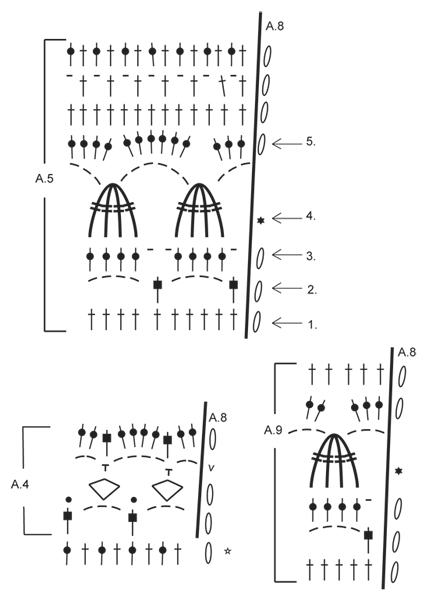
|
||||||||||||||||||||||||||||||||||||||||||||||||||||||||||
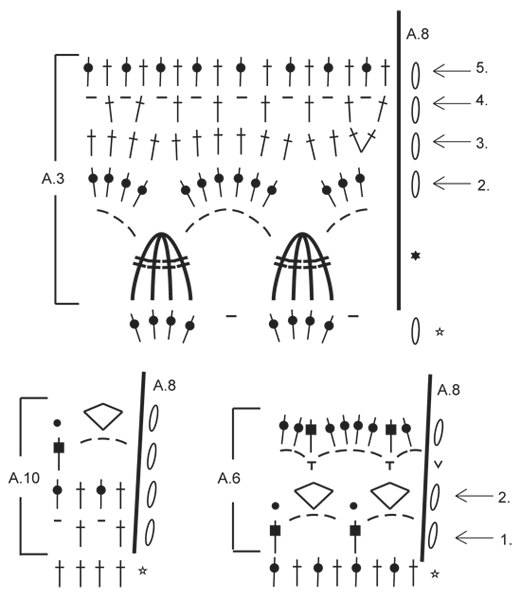
|
||||||||||||||||||||||||||||||||||||||||||||||||||||||||||

|
||||||||||||||||||||||||||||||||||||||||||||||||||||||||||
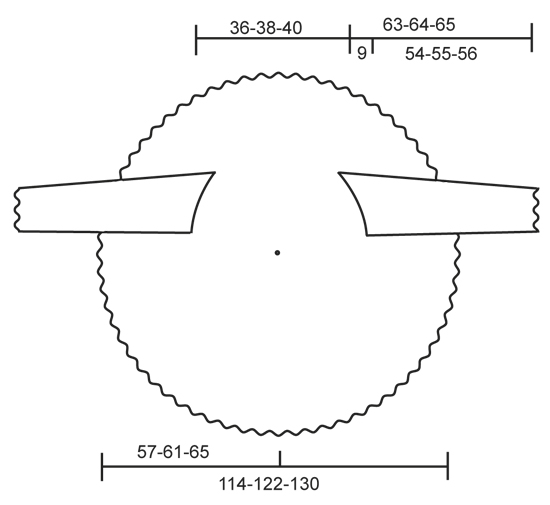
|
||||||||||||||||||||||||||||||||||||||||||||||||||||||||||
Have you finished this pattern?Tag your pictures with #dropspattern #seaglassjacket or submit them to the #dropsfan gallery. Do you need help with this pattern?You'll find 11 tutorial videos, a Comments/Questions area and more by visiting the pattern on garnstudio.com. © 1982-2025 DROPS Design A/S. We reserve all rights. This document, including all its sub-sections, has copyrights. Read more about what you can do with our patterns at the bottom of each pattern on our site. |
||||||||||||||||||||||||||||||||||||||||||||||||||||||||||







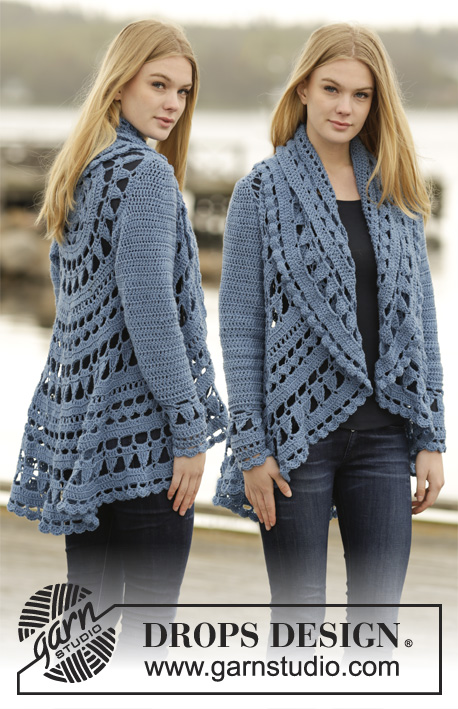
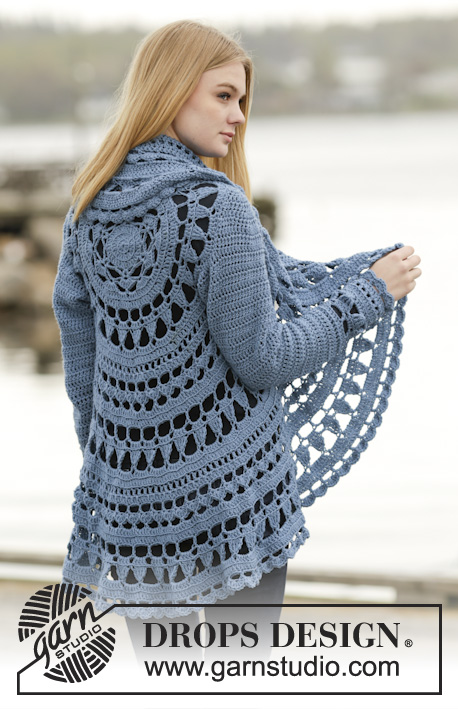

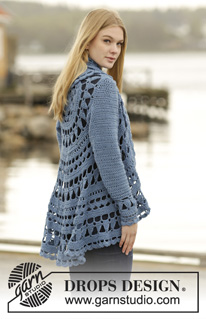

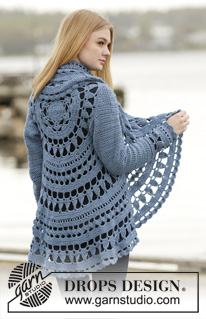






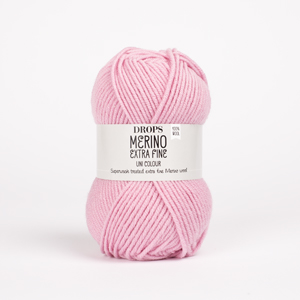
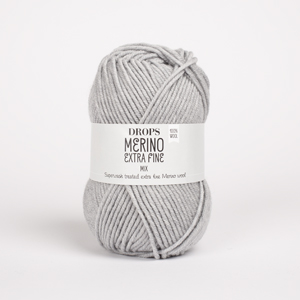

















































Post a comment to pattern DROPS 164-16
We would love to hear what you have to say about this pattern!
If you want to leave a question, please make sure you select the correct category in the form below, to speed up the answering process. Required fields are marked *.